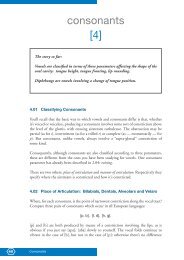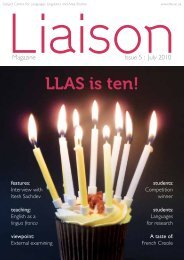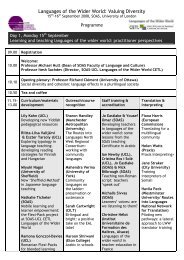PHONETICS MANUAL.indd - HumBox
PHONETICS MANUAL.indd - HumBox
PHONETICS MANUAL.indd - HumBox
You also want an ePaper? Increase the reach of your titles
YUMPU automatically turns print PDFs into web optimized ePapers that Google loves.
that learners of English as a foreign language have the opposite difficulty, and may well<br />
have even greater problems: learning to imitate the exact starting and finishing points<br />
of English diphthongs is a very difficult task. It’s all the more difficult as quite slight<br />
variations in the precise tongue movement for some of the English diphthongs can<br />
change their nature greatly: anglophones are well attuned to such differences, as these<br />
can be informative about a person’s regional or social origin.<br />
Thus if the o of so is pronounced [Eu] rather than [@u] (i.e. with the first element fronted),<br />
the effect is perceived as “refined” or “posh”. By contrast, if the first element is again fronted<br />
but also lowered slightly (to [æ]), the resulting [æu] is felt to be “vulgar” or “uneducated”.<br />
Not that there is anything inherently posh or otherwise about the sounds themselves: it’s a<br />
matter of who uses them and in what context. If the “refined” [eu] just referred to is used<br />
instead of the RP [au] in how, it instantly takes on “sub-standard” associations itself.<br />
English has monophthongs as well of course, as we saw earlier (in words like head, had,<br />
hid, for example). But so prone are RP-users (and Southern British speakers in general)<br />
to “diphthongize” vowels that the long monophthongs in feed or food are preceded by<br />
a distinct “onglide” — i.e. a movement of the tongue giving a hint of the presence of<br />
another element besides the vowel itself. So not only is the vowel of RP see more retracted<br />
than Cardinal No.1 (illustrated by French si), it’s also slightly diphthongized: [Ii].<br />
Similarly for English route compared with Cardinal 8 (or French route): [Uu].<br />
You can see from Fig. 22 that the tongue moves through only a short distance. So these<br />
Fig. 22<br />
i<br />
u<br />
I<br />
U<br />
e<br />
o<br />
sounds are considered as “diphthongized vowels” rather than fully-fledged diphthongs,<br />
and are normally transcribed just [i] and [u] for convenience. At least, that applies to<br />
RP: for some London speakers, this onglide is of much the same duration as a true<br />
diphthongal element, and the distance travelled by the tongue is greater: therefore<br />
the transcription [@i] is justified for diphthongs like the one heard in the Cockney<br />
pronunciation of feed.<br />
Exercises<br />
i<br />
u<br />
e<br />
@<br />
o<br />
E<br />
O<br />
Fig. 23<br />
a<br />
A<br />
34 Vowels






